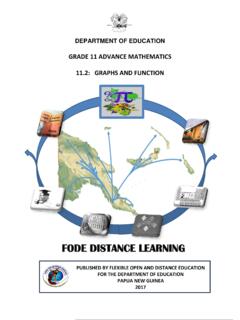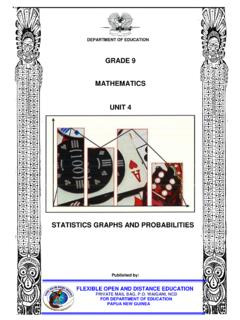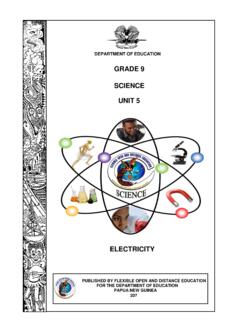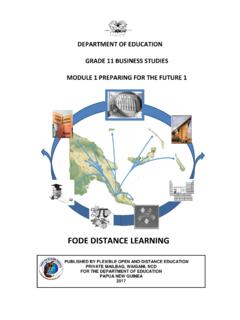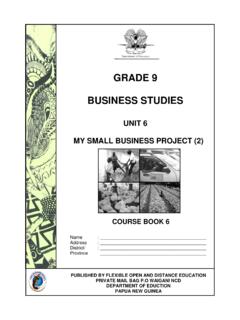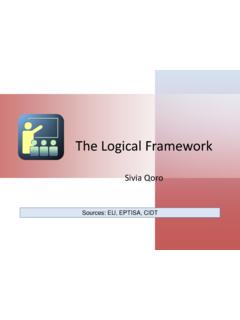Transcription of WORK, POWER AND ENERGY - FODE | Home
1 WORK, POWER AND ENERGY DEPARTMENT OF EDUCATION GRADE 11 MODULE 4 PUBLISHED BY FLEXIBLE OPEN AND DISTANCE EDUCATION PRIVATE MAIL BAG, WAIGANI, NCD FOR DEPARTMENT OF EDUCATION papua NEW guinea 2017 PHYSICS Writer Gideon Messa & Vincent Kapui Content Editors Science Department Subject Review Committee Language Editor Dr. Mirzi. L. Betasolo Course Format Editor Elizabeth. W. Aimundi GR 11 PHYS M4 TITLE 1 GRADE 11 PHYSICS MODULE 4 WORK, POWER AND ENERGY IN THIS MODULE, YOU WILL LEARN ABOUT: : WORK : POWER : ENERGY : SIMPLE MACHINES GR 11 PHYSICS M4 ACKNOWLEDGEMENT & ISBN 2 Flexible Open and Distance Education papua New guinea Published in 2017 Copyright 2017, Department of Education papua New guinea All rights reserved.
2 No part of this publication may be reproduced, stored in a retrieval system, or transmitted in any form or by any means electronic, mechanical, photocopying, recording or any other form of reproduction by any process is allowed without the prior permission of the publisher. Printed by the Flexible, Open and Distance Education ISBN 978-9980-89-546-2 National Library Services of papua New guinea Acknowledgement We acknowledge the contribution of all Lower and Upper Secondary teachers who in one way or another helped to develop this Course. Our profound gratitude goes to the former Principal of FODE, Mr.
3 Demas Tongogo for leading FODE towards this great achievement. Special thanks are given to the staff of the Science Department of FODE who played active roles in coordinating writing workshops, outsourcing of module writing and editing processes involving selected teachers of Central Province and NCD. We also acknowledge the professional guidance and services provided through-out the processes of writing by the members of: Science Subject Review Committee-FODE Academic Advisory Committee-FODE Science Department- CDAD This book was developed with the invaluable support and co-funding of the GO-PNG and World Bank.
4 DIANA TEIT AKIS Principal-FODE . GR 11 PHYS M4 CONTENTS 3 TABLE OF CONTENTS Page 1 Acknowledgement & 2 3 Secretary s 4 MODULE : WORK, POWER AND ENERGY 5 - 76 Course 5 - 6 Learning 7 Time 8 : 9 - 18 9 - 18 : 18 - 25 18 - 25 : 26 - 46 Types of 26 - 27 Gravitational Potential 27 - 33 Kinetic 33 - 38 The Law of Conservation of 38 - 39 ENERGY 39 - 46.
5 Simple 46 64 Simple 9 46 - 49 Levers, Ramps and Wheel and 9 49 - 56 Screws, Wedges and 9 57 - 64 65 - 68 Answers to Learning 69 - 76 77 GR 11 PHYS M4 MESSAGE 4 SECRETARY S MESSAGE Achieving a better future by individual students, their families, communities or the nation as a whole, depends on the kind of curriculum and the way it is delivered. This course is part of the new Flexible, Open and Distance Education curriculum. The learning outcomes are student-centred and allows for them to be demonstrated and assessed.
6 It maintains the rationale, goals, aims and principles of the National Curriculum and identifies the knowledge, skills, attitudes and values that students should achieve. This is a provision by Flexible, Open and Distance Education as an alternative pathway of formal education. The Course promotes papua New guinea values and beliefs which are found in our constitution, Government policies and reports. It is developed in line with the National Education Plan (2005 2014) and addresses an increase in the number of school leavers affected by lack of access into secondary and higher educational institutions.
7 Flexible, Open and Distance Education is guided by the Department of Education s Mission which is fivefold; To develop and encourage an education system which satisfies the requirements of papua New guinea and its people To establish, preserve, and improve standards of education throughout papua New guinea To make the benefits of such education available as widely as possible to all of the people To make education accessible to the physically, mentally and socially handicapped as well as to those who are educationally disadvantaged The College is enhanced to provide alternative and comparable path ways for students and adults to complete their education.
8 Through one system, two path ways and same learning outcomes. It is our vision that papua New Guineans harness all appropriate and affordable technologies to pursue this program. I commend all those teachers, curriculum writers, university lecturers and many others who have contributed so much in developing this course. UKE KOMBRA, PhD Secretary for Education GR 11 PHYS M4 INTRODUCTION 5 MODULE 11. 4: WORK, POWER AND ENERGY Introduction In this module, you will learn the fundamentals of WORK, POWER and ENERGY and their applications in everyday simple machines. The terms work, POWER and ENERGY are often used in our daily conversations but have different meanings in Physics.
9 This module will give specific scientific meanings and explanations to these terms. Our daily usage of the term work refers to activities like cleaning your room, fetching water, doing household chores or being employed. Imagine a boy pushing against a brick wall. Is he doing any work? You would definitely say yes! However, in Physics the boy is not doing any work, though the contractions and expansions of his muscles can be seen and he may even be sweating. Work done is associated to a constant force applied on an object and the displacement of the object in the direction of the force. Therefore if there is NO movement there is NO work.
10 Similarly, imagine mothers carrying bags of vegetables on their heads to the market every day. It may seem that they are doing a lot of work, but again in Physics, they are not doing any work. There is no work done when the direction of the applied force and the direction in which the object moves are perpendicular to each other. Work done can be calculated as the product of the applied force and the distance moved by the object in the direction of the applied force (dFW ).Work is measured in joules (J). POWER in our everyday language is usually associated with force and authority. When a person is able to get things done quickly and according to his wishes, we say he is powerful.
